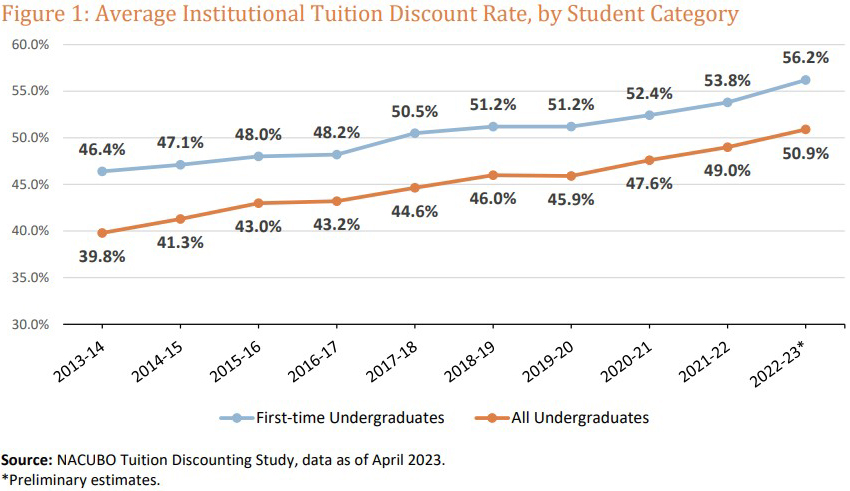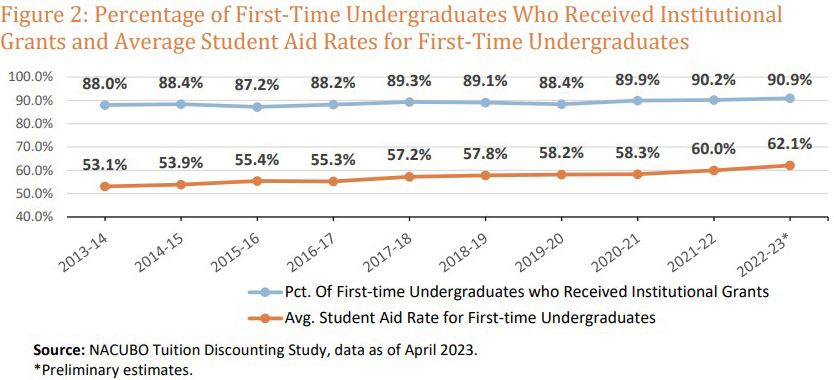Tuition Discount Rates at Private Colleges and Universities Top 50 Percent
4/24/2023
(Washington, DC)—Average private college and university tuition discount rates reached new highs this academic year.
In the 2022 NACUBO Tuition Discounting Study, 341 private, nonprofit colleges and universities reported an estimated 56.2 percent average institutional tuition discount rate for first-time, full-time, first-year students in academic year (AY) 2022-23 and 50.9 percent for all undergraduates—both record highs. By providing grants, fellowships, and scholarships, these institutions forgo more than half the revenue they otherwise would collect if they charged all students the tuition and fee sticker price.

Estimates show that the vast majority of undergraduate students at these institutions received grant aid this year, and the awards were, on average, the largest yet. In AY 2022-23, 90.9 percent of first-time undergraduates at institutions surveyed received institutional grant aid, which covered an average of 62.1 percent of published tuition and fees. Among all undergraduates, 82.9 percent received grant aid, covering an average of 57.6 percent of the published price.

“Discounting tuition is a key way independent colleges and universities make education affordable for students—many of whom are paying significantly less than their school’s published prices,” said Ken Redd, senior director of research and policy analysis at NACUBO. “At the same time, leaders remain mindful of the impact institutional grant expenses may have on their school’s overall finances.”
These private institutions use a variety of sources to fund grant aid awards. In 2021-22 (the most recent year for which this data is available) 56.5 percent of grant aid funding came from undedicated sources of revenue, including unbudgeted general funds, unplanned contributions, and foregone revenue. An additional 28.6 percent came from institutional reserves, and 10.4 percent was funded by endowment earnings and withdrawals.
“Business officers continue to think strategically about how to best allocate resources to maintain a commitment to affordable postsecondary education,” Redd said.
Institutions that are the most selective in admissions tend to discount tuition less than other schools. At selective/highly selective institutions (defined as those that offer admission to less than 51 percent of applicants), the median institutional discount rate for first-time undergraduates in 2022-23 was 46.8 percent, nearly 12 percentage points lower than the median institutional discount rate for institutions overall (58.7 percent).
Institutions were split on enrollment changes. Across all survey respondents, enrollment decreased, on average, by about 1 percent among both first-time undergraduates and all undergraduate populations—but more than 100 institutions in the survey reported enrollment increases.
After accounting for inflation, net tuition and fee revenue decreased by 5.4 percent per first-time undergraduate and by 5.9 percent among all undergraduates. Institutions with minimally selective admissions criteria were slightly less affected by declines in net tuition revenue.
About NACUBO
Founded in 1962, the National Association of College and University Business Officers (NACUBO) is a nonprofit professional organization representing chief administrative and financial officers at more than 1,700 colleges and universities across the country. NACUBO works to advance the economic vitality, business practices, and support of higher education institutions in pursuit of their missions. For more information, visit www.nacubo.org.